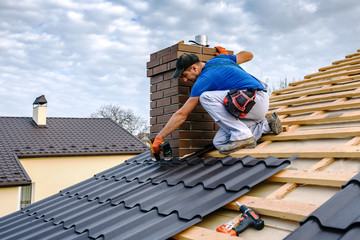There are several types of roofing materials available for your home. If you want to protect your home from ultraviolet rays, you may want to use mineral wool roofing. Its compressive strength is much higher than fiberglass. Another type of roofing material is cellulose, recycled newsprint. It would be best to look for coatings that resist fire and mold. But before you choose this type of roofing material, consider wind and other factors to determine whether it is suitable for your home.
 There are many benefits to a flat roof, including its ability to reduce evaporation. This material is highly durable, so it is best to seek the services of a professional roofer. A properly-constructed roof will prevent the weather from compromising your home or business. And if you decide to go with a flat roof, you should consider the pros and cons of each type before making the final decision. Roofing materials are not only functional, but they are also attractive.
There are many benefits to a flat roof, including its ability to reduce evaporation. This material is highly durable, so it is best to seek the services of a professional roofer. A properly-constructed roof will prevent the weather from compromising your home or business. And if you decide to go with a flat roof, you should consider the pros and cons of each type before making the final decision. Roofing materials are not only functional, but they are also attractive.
Roofing materials can be constructed to meet specific specifications. For example, an open-valley roof may have metal or vegetative roofing. This type of roof does not cover the entire valley. A roof’s installation begins with a saturant; an asphalt-based substance used to waterproof the felt and provide strength. Next, the contractor should apply a seal down, an asphalt-covered strip that provides additional wind resistance. After saturant and the felt, the roof may be covered by sheathing and exterior grade boards. A skirt flashing or soffit will finish the underside of the eave.
There should be at least two pre-roofing conferences. One should take place several weeks before the roofing begins. These meetings aim to review drawings and specifications, identify problems, and make necessary adjustments before the roofing begins. The contractor should prepare the minutes of these meetings and distribute them to other parties involved in the roofing process. Then, the work can start. This step will ensure that the roof will be installed on time.
Building codes require documentation related to roof systems. The 2012 edition of the IBC (International Building Code) includes construction document requirements for roof systems. It is essential that designers not rely on building departments to discover code-compliance problems because they do not have sufficient knowledge of roof systems. In addition, most building inspectors do not have the expertise necessary to inspect roof systems. If you are considering hiring a professional roofer, you should check the state’s building code requirements.
Roof details vary widely depending on the type of roofing material. The AIA structural graphic standard includes low and steep-slope details. But these details have not undergone extensive industry reviews. There are also industry standards, such as the NRCA, used by roofing companies. However, manufacturers also promulgate their details. These are generally accepted by the roofing industry and are suitable for standard conditions. For the most part, these details can be used to make a design.
In addition to the material used for roofing, some critical considerations for a design are also essential. First, the procedure will determine the type of roof system. Several types of roofing systems, such as sprayed polyurethane foam, asphalt shingles, and slate. Another important consideration is the roof’s attachment style. You can choose a loosely laid air-pressure-equalized roofing system or a mechanically-attached system.
A good roof will protect from the elements and add value to the home. The material you choose should last for many years and not wear out. Roofing professionals will be able to offer the right roof for your home. You should look for a roofer who has a lot of experience and specializes in the type of material that you need. This can be a huge help when selecting a material for your home. So, get a quote today.
Besides choosing suitable roofing material, you should also look for a warranty. Some manufacturers provide warranties on their roofing products, but these should not be the only considerations. Look for a warranty covering the entire roofing system, and make sure it doesn’t have a dollar limit or prorated coverage. The contract should also cover all materials and accessories, not just the shingles. It should also be prorated, and the warranty should cover repairs or replacement costs and the materials.
